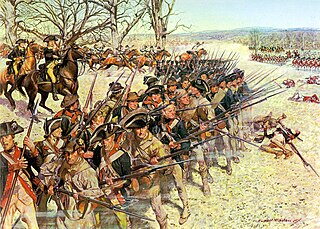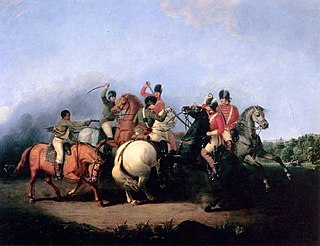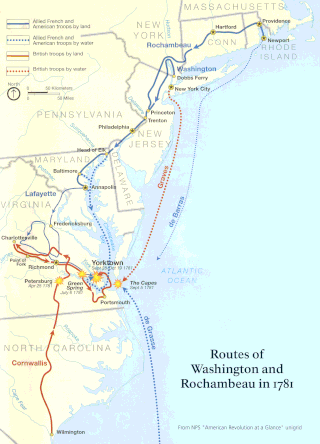
The siege of Yorktown, also known as the Battle of Yorktown and the surrender at Yorktown, began September 28, 1781, and ended on October 19, 1781, at exactly 10:30 am in Yorktown, Virginia. It was a decisive victory by a combined force of the American Continental Army troops led by General George Washington with support from the Marquis de Lafayette and French Army troops led by the Comte de Rochambeau and a French naval force commanded by the Comte de Grasse over the British Army commanded by British Lieutenant General Charles Cornwallis.

The Battle of Guilford Court House was on March 15, 1781, during the American Revolutionary War, at a site that is now in Greensboro, the seat of Guilford County, North Carolina. A 2,100-man British force under the command of Lieutenant General Charles Cornwallis defeated Major General Nathanael Greene's 4,500 Americans. The British Army suffered considerable casualties, with estimates as high as 27% of their total force.

General Sir Banastre Tarleton, 1st Baronet was a British military officer and politician. He is best known as the lieutenant colonel leading the British Legion at the end of the American Revolutionary War. He later served in Portugal and held commands in Ireland and England.

Armand Louis de Gontaut, duc de Lauzun, later duc de Biron, and usually referred to by historians of the French Revolution simply as Biron, was a French soldier and politician, known for the part he played in the American War of Independence and the French Revolutionary Wars. In 1773, he was Grand second warden of Grand Orient de France.

The British Legion was an elite British provincial regiment established during the American Revolutionary War, composed of Loyalist American troops, organized as infantry and cavalry, plus a detachment from the 16th Light Dragoons. The unit was commonly known as Tarleton's Legion, after the British officer who led it on campaign, Lieutenant Colonel Banastre Tarleton. It was a unit the size of a regiment, consisting of artillery, cavalry, and light infantry, and able to operate independently.

Jean-Baptiste Donatien de Vimeur, comte de Rochambeau was a French Royal Army officer and nobleman who played a critical role in the Franco-American victory at siege of Yorktown in 1781 during the American Revolutionary War. He was commander-in-chief of the Expédition Particulière, the French expeditionary force sent to help the Americans fight against British forces.
Jean-Bernard Gauthier de Murnan was a French officer for the Continental Army and a French general during the French Revolution.

The Battle of Cowpens was a military engagement during the American Revolutionary War fought on January 17, 1781, near the town of Cowpens, South Carolina. American Patriot forces, estimated at 2,000 militia and regulars under Brigadier General Daniel Morgan faced 1,000 British troops under Lieutenant Colonel Banastre Tarleton.

The Yorktown campaign, also known as the Virginia campaign, was a series of military maneuvers and battles during the American Revolutionary War that culminated in the siege of Yorktown in October 1781. The result of the campaign was the surrender of the British Army force of General Charles Earl Cornwallis, an event that led directly to the beginning of serious peace negotiations and the eventual end of the war. The campaign was marked by disagreements, indecision, and miscommunication on the part of British leaders, and by a remarkable set of cooperative decisions, at times in violation of orders, by the French and Americans.

The southern theater of the American Revolutionary War was the central theater of military operations in the second half of the American Revolutionary War, 1778–1781. It encompassed engagements primarily in Virginia, Georgia, North Carolina, and South Carolina. Tactics consisted of both strategic battles and guerrilla warfare.

The siege of Yorktown was the culminating act of the Yorktown campaign, a series of military operations occupying much of 1781 during the American Revolutionary War. The siege was a decisive Franco-American victory: after the surrender of British Lt. Gen. Charles, Earl Cornwallis on October 17, the government of Lord North fell, and its replacement entered into peace negotiations that resulted in British recognition of American independence with the 1783 Treaty of Paris.

Louis-Philippe de Rigaud, Marquis de Vaudreuil was second in command of the French squadron off America during the American Revolutionary War.

Alexander Scammell was an American military officer and attorney who served in the Continental Army during the American Revolutionary War. He was wounded on September 30, 1781, near Yorktown and subsequently died on October 6 in Williamsburg, Virginia, making him, a colonel, the highest ranking American officer killed during the Siege of Yorktown.

The Gâtinais Regiment was a French infantry regiment created in 1776 under the Ancien Régime. It fought in the American Revolutionary War and in 1781 received the name of Royal-Auvergne in recognition of its gallant service during the American campaign.

The Washington–Rochambeau Revolutionary Route is a 680-mile (1,090 km) series of roads used in 1781 by the Continental Army under the command of George Washington and the Expédition Particulière under the command of Jean-Baptiste de Rochambeau during their 14-week march from Newport, Rhode Island, to Yorktown, Virginia.

The Special Expedition was an expeditionary force deployed by France to North America to support the United States against Great Britain during the American Revolutionary War. Arriving on 11 July 1780 under the leadership of the Comte de Rochambeau, it numbered up to 5,500 troops and played a decisive role in the final battles of the war.
The 5th Hussar Regiment was a French Hussar regiment.

The Daniel Basset House is a historic house at 1024 Monroe Turnpike in Monroe, Connecticut, built in 1775. It is significant for its association with events in the American Revolutionary War. It is documented to have hosted a ball for French officers of Lauzun's Legion on June 30, 1781; the legion had been encamped near the village center of Monroe. The house was listed on the National Register of Historic Places in 2002.
Jan Kwiryn de Mieszkowski was a Polish cavalryman and officer in the American Revolution and the French Revolution.












